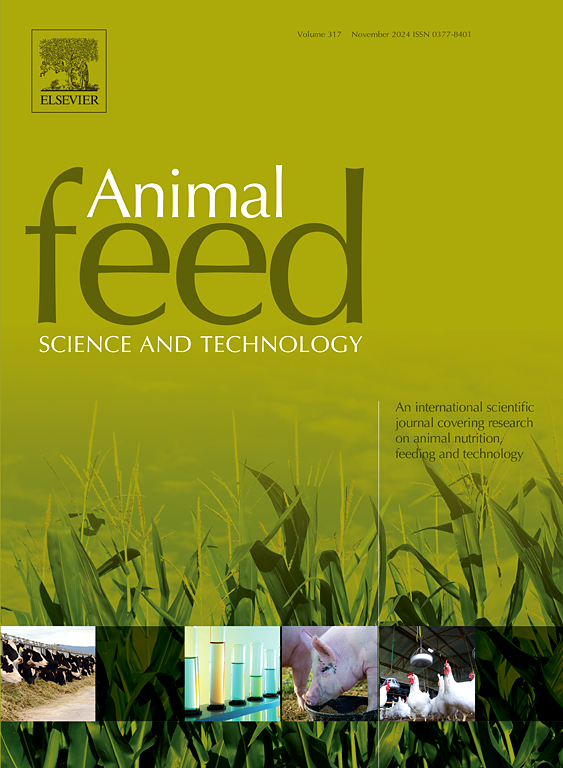Effects of supplementation frequency on nutritional performance and metabolism of cattle fed low-quality tropical forage
IF 2.5
2区 农林科学
Q1 AGRICULTURE, DAIRY & ANIMAL SCIENCE
引用次数: 0
Abstract
Our objective was to evaluate the nutritional performance and metabolism of cattle fed low-quality tropical grass forage and supplemented at different frequencies. Five rumen and abomasum fistulated Nellore heifers (386 kg body weight) were used in a 5 × 5 Latin square design. The five treatments were: control (without supplementation) and supplementation every 12, 24, 48, and 96 h. The amount of supplement provided was equivalent to 2.5 g/kg of body weight in a daily basis. Overall, supplementation had a positive effect (P<0.01) on voluntary forage intake. However, among the supplemented treatments, a decreasing linear effect (P<0.04) on forage intake was observed as the intervals between supplementations extended. The provision of supplements increased (P<0.02) body N accretion, rumen N balance, and microbial N production in the rumen. However, microbial N production responded quadratically (P<0.04) to the supplementation frequency, reflecting a sharp drop when supplement was provided every 96 h. An interaction between treatments and days of the supplementation cycle was observed for ruminal ammonia N (RAN; P<0.01). The interaction indicated day-to-day variations (P<0.01) when supplementation occurred every 48 or 96 hours. In these cases, RAN concentrations peaked (P<0.05) on supplement provision days. Urinary N excretion (UN) was higher (P<0.01) with the provision of supplements. However, UN showed an interaction effect between treatments and days of the supplementation cycle (P<0.01), where variations across days were only observed for supplementation every 96 hours. In this case, N excretion peaked (P<0.05) the day following supplementation. Infrequent supplementation strategies do not adversely affect the nutritional performance of cattle consuming low-quality tropical forages as long as supplementation intervals do not exceed two days.
补充频率对饲喂劣质热带牧草的牛的营养表现和新陈代谢的影响
我们的目的是评估饲喂劣质热带牧草并以不同频率补充牧草的牛的营养表现和新陈代谢情况。我们采用 5 × 5 拉丁正方形设计,饲养了五头瘤胃和腹腔瘘管内洛尔小母牛(体重 386 千克)。五种处理分别为:对照组(不补充)和每 12、24、48 和 96 小时补充一次。每天的补充量相当于每公斤体重 2.5 克。总的来说,补饲对自愿草料摄入量有积极影响(P<0.01)。然而,在添加辅食的处理中,随着添加辅食间隔时间的延长,对草料摄入量的线性影响呈下降趋势(P<0.04)。补饲增加了(P<0.02)体内氮的积累、瘤胃氮平衡和瘤胃中微生物氮的产生。然而,微生物产氮量与补充频率呈二次方关系(P<0.04),当每隔 96 小时补充一次时,微生物产氮量急剧下降。瘤胃氨氮(RAN;P<0.01)在处理和补充周期天数之间存在交互作用。当每 48 或 96 小时补充一次瘤胃氨氮时,这种交互作用表明每天都有变化(P<0.01)。在这些情况下,RAN 浓度在提供补充剂的日子达到峰值(P<0.05)。提供补充剂时,尿氮排泄量(UN)较高(P<0.01)。但是,UN 在处理和补充周期天数之间存在交互影响(P<0.01),只有在每 96 小时补充一次的情况下才能观察到不同天数之间的差异。在这种情况下,氮的排泄量在补充后的第二天达到峰值(P<0.05)。只要补充间隔不超过两天,不频繁的补充策略不会对食用劣质热带饲草的牛的营养表现产生不利影响。
本文章由计算机程序翻译,如有差异,请以英文原文为准。
求助全文
约1分钟内获得全文
求助全文
来源期刊

Animal Feed Science and Technology
农林科学-奶制品与动物科学
CiteScore
6.00
自引率
6.20%
发文量
266
审稿时长
3 months
期刊介绍:
Animal Feed Science and Technology is a unique journal publishing scientific papers of international interest focusing on animal feeds and their feeding.
Papers describing research on feed for ruminants and non-ruminants, including poultry, horses, companion animals and aquatic animals, are welcome.
The journal covers the following areas:
Nutritive value of feeds (e.g., assessment, improvement)
Methods of conserving and processing feeds that affect their nutritional value
Agronomic and climatic factors influencing the nutritive value of feeds
Utilization of feeds and the improvement of such
Metabolic, production, reproduction and health responses, as well as potential environmental impacts, of diet inputs and feed technologies (e.g., feeds, feed additives, feed components, mycotoxins)
Mathematical models relating directly to animal-feed interactions
Analytical and experimental methods for feed evaluation
Environmental impacts of feed technologies in animal production.
 求助内容:
求助内容: 应助结果提醒方式:
应助结果提醒方式:


